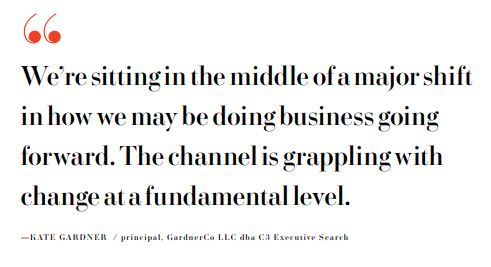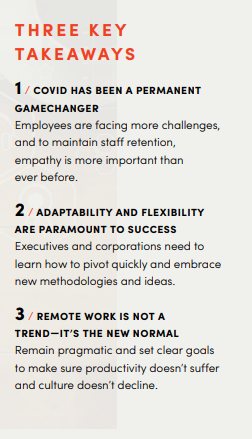What’s relevant, What’s marketable and What’s complicated.
Hard skills—the nuts and bolts, platforms and apps, methodologies and strategies on every executive’s CV—may change slightly from year to year, but the overarching categories of data and tech have remained constant since digital technology became the standard-bearer for corporate growth.
Perpetual evolution in these areas press the most marketable executives forward in their skill sets to keep pace with what’s necessary to grow businesses, and at the same time increase the relevance of companies and the likelihood they can attract and retain valuable employees.

The need to interpret and analyze data and implement growth strategies that harness the most current technologies, cuts across industry disciplines. It’s no longer the exclusive purview of the Chief Information Officer. In fact, it bleeds into every executive role and can affect the softer, nuanced skills and decision making of corporate leaders who want to build solid and successful teams.
“Every good executive needs to be data-oriented and understand finance related to overall business structure—the ‘where’s and ‘why’s of how monies are assigned,” said Kate Gardner, principal, GardnerCo LLC dba C3 Executive Search.
That’s because companies are being driven to do things differently, whether it’s due to COVID, compliance issues leading them to more customer-centric business strategies, remote work expectations, mergers or downsizing. Change has come to the entire channel, and it’s complicated.
“We’re sitting in the middle of a major shift in how we may be doing business going forward. The channel is grappling with change at a fundamental level, from current complexities to digital and regulatory driven opportunities,” Gardner explained.

To lead through these challenging and changing times, executives involved in planning and growth strategy certainly need to be data-oriented, analytical, understand business drivers and apply all this to finance. But it’s tempting to get lost in those hard skills and quantifiable data, relying so heavily on them you lose sight of the person that “got” that number or “is” that number.
People are going through a lot of challenges coming out of COVID. With all the life-impacting adjustments to work and personal lives made over the past few years, psychological and mental health challenges have surfaced. People have changed.
As a result, anyone in organizational leadership needs to have more empathy than they did before. They need to be able to communicate and lead with more nuance than was once required of them, Sean Eggert, CEO, Hanna Shea Consulting, said.
“You can carry on with business as usual, but you’re going to be losing executives left and right and constantly replacing people. Take time to get to know your team and make them feel supported. Right now, more than ever, it’s about building really strong community,” Eggert said.

Fast Adapting Mavericks
Hard work is second nature to the direct selling industry. When executives rise from the sales field, particularly, they bring with them an “eat what you kill” work ethic that drives them to adapt quickly. This maverick characteristic pushes them to do everything in their power to figure out an angle to improve, to increase numbers, to do things better.
As an industry recruiter, Eggert sees the frustration of these executive mavericks, who are extremely tech savvy, excel on social media and possess incredible communications skills but work for companies that lag behind.
COVID accelerated corporate adaptation, forcing policy and business strategy changes, software platform improvements and even complete re-creations. Larger companies with more resistant field organizations felt greater pain, than did smaller ones whose fields had looser ties to existing methods and platforms. It’s a change some executive candidates tell Eggert was overdue.
After outpacing their companies in adaptability, these executives desire organizations that embrace change and technology more readily; therefore, allowing them to refine their skills, grow individually and implement new strategies on behalf of their new employers.
When an executive is ready for more and could step up within a company, often they are disillusioned because no career advancement path exists. A quick look at the company hierarchy tells the story. These executives simply have no place to go but out.

“We’ve had a tendency, because we’ve had so many great years of growth in our channel, to add willy-nilly without giving consideration to an actual org structure,” Gardner said. “HR is always good at and trained to identify and help organize the structure internally, so they have the right people onboard for today and a year from now, presuming they need these levels they are aspiring to.”
But too often, HR isn’t part of strategic growth planning. Gardner believes there’s a lot to be gained in studying this internal people component from both the corporate and individual perspectives.
Remote Work Debate
Nowhere is the people component more obvious than the debate surrounding remote work. What began as a whisper pre-COVID with Millennials and Gen Xers is a post-pandemic phenomenon no longer unique to that demographic.
“They are searching for the Holy Grail of work/life balance. With COVID leading to remote work and having had a taste of that and the freedom that it provides, they have no interest in returning to an office environment,” said Debbie Squire, President, IMPACT This Day.
“There’s no magic bullet with remote work. It becomes part of our culture moving forward and each company’s work/life balance culture is going to be different from another, for all the legitimate reasons based upon who that company is and who leads them,” Gardner said.

“It just makes sense in an executive’s mind to let them do what they do from wherever they want to do it, as long as the job is being done to meet expectations or beyond,” Eggert said.
After all, it is a “trust but verify situation,” according to Eggert.
Some newer and mid-sized companies operate entirely remote and as a result, expectations are clear from the beginning for everyone at every level including the CEO. “It all comes down to solid reporting and communications, whether you are the CEO reporting to the Founder or the Director reporting to the VP,” Eggert said.
The contentious nature of remote work has some executives driving a proverbial stake into the ground refusing to relocate or come into the office full-time, while some companies take a hard line citing sacrifices in culture and questioning productivity.
“Executives need to be more pragmatic, particularly when leading their teams. One example would be looking at employee output versus hours worked. I am hearing from more of my clients that they see productivity levels dropping and they are poising themselves to be more rigid in respect to remote work,” Squire said.

Eggert doesn’t buy into the idea that remote work is somehow adversely affecting productivity. With set expectations for every hired position, a set of achievements and clear goals, it’s not hard to measure a person’s productivity whether they are in or out of the office.
“It’s always about reporting, and it’s about data. The fact that people were forced to work from home during COVID and now are demanding that ability—at least in a hybrid—I think helps because it comes down to data. There’s a lot more rigidity, in terms of reporting and communication. In all honesty, it is a great thing, as compared to when we were all in the office and maybe there wasn’t that same requirement,” Eggert said.
Hardworking professional executives want to be able to report in each week about what they’ve accomplished. Push back shouldn’t exist because they should relish the idea of communicating and be good at it. It’s expected of them because it is what they expect from their teams.
Perhaps, it is in the data where executive job candidates and direct selling companies can find common ground on the remote work issue and exercise the empathetic leadership traits that lead to effective collaboration and a win for the individuals, the companies and the industry.
From the January/February 2023 issue of Direct Selling News magazine.


